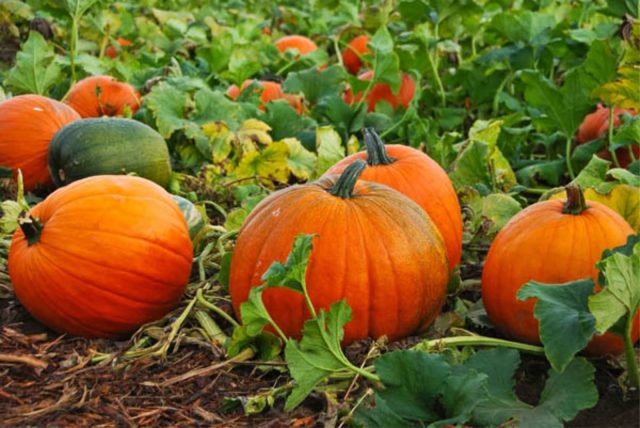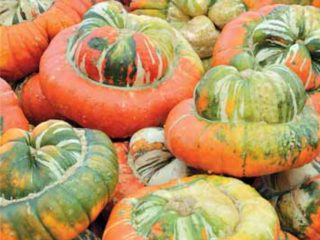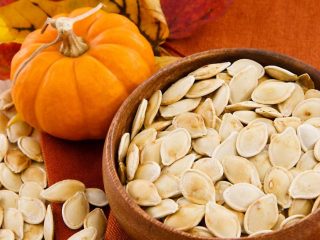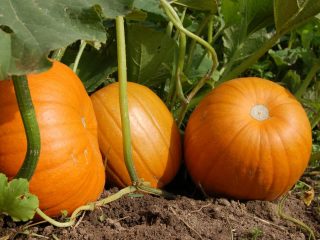Content
- 1 What water to water
- 2 Watering methods
- 3 How to water pumpkin outdoors during dry periods
- 4 Features of watering during flowering
- 5 How to water a pumpkin during fruit formation
- 6 Periodicity
- 7 When to water: morning or evening
- 8 How to water properly
- 9 What mistakes are most often made by gardeners
- 10 Conclusion
Watering pumpkins in the open field should be carried out according to a special regimen at certain periods of vegetable growth. The irrigation rules are simple, but only when they are followed will the mistakes of gardeners be excluded, then it will be possible to grow a juicy sweet pumpkin in the summer cottage.
What water to water
Not all water can be used to water a pumpkin. The water must be clean and not cold. Recommended temperature for watering - +200C. If you water it with ice water, the plant will get stress and will inhibit its development. Irrigation water should not be cloudy or dirty in order to prevent the development of fungal diseases in the plant.
According to the source of formation, water is divided into several groups:
- rain;
- plumbing;
- well or key;
- river, lake, pond.
Rainwater is considered the most desirable and favorable, but on condition that there are no sources of chemical emissions into the air in the vicinity of the growth. Rainwater for irrigation can be prepared in advance by placing containers in the form of barrels and buckets under the drainpipes to collect it. And then, using a pump or a watering can, use it to irrigate the garden.
Tap water is the most readily available - just turn on the tap and water. But in this case, it should be borne in mind that it has a low temperature for a pumpkin. To pour water from the pipeline network, it is recommended to collect it in a tank and leave it to heat in the sun.
Spring water is good for irrigation not only because of its purity, but also because it contains natural elements that the plant needs for its rapid growth. However, she also needs to be allowed to warm up before watering.
To use water from an open source for watering pumpkin in the open field, it is necessary to stand it for a while in order to weed out excess particles and pay attention to whether a film forms on the surface - evidence of the presence of poisonous substances in the liquid.
Watering methods
Gardeners use several methods of watering vegetables, each of which can be applied to pumpkin watering:
- manual;
- semi-automatic;
- auto.
The most common and simplest is manual watering using a watering can or hose. It is most suitable for small suburban areas with small beds. This method must be applied carefully so as not to destroy young shoots and erode the soil, exposing the roots. For this, a nozzle is put on the watering can, and the edge of the hose is clamped so that water is sprayed from it, and does not flow out in a strong stream. There are special nozzles for the hose, with which you can adjust the force and shape of the jet.
Semi-automatic watering of pumpkin is best organized in large areas of the country. The gardener only turns on and off the tap. He does not need to manually water each bush. To do this, the garden pipeline is looped back and hoses are laid from it along the section of the beds where watering should take place. Small holes are made in the pipes through which water flows in thin streams to the root system of vegetables. It is necessary to make sure that during such watering the pumpkin roots are not washed out.
The automatic system turns on and off independently according to the set mode. For this, it has a timer that controls the watering time. This means that this method is the least labor-intensive, but more expensive.
How to water pumpkin outdoors during dry periods
When the weather is hot and there is no rain, the pumpkin especially needs abundant watering. At this time, you need to monitor the plant and the condition of its tops. If the leaves have a wilted, wilted appearance, or they began to turn yellow and dry, then this means that the vegetable does not have enough moisture.
In hot dry weather, pumpkin is watered more often than usual - once every 2 days, in the evening after sunset. During the night, moisture will moisten the soil well and the plant will have time to absorb enough moisture.
Features of watering during flowering
The greatest care should be taken for the pumpkin during flowering and ovary formation. At this time, the fate of the future harvest is being decided, a lack of moisture can lead to the fall of flowers and ovaries. The plant becomes sensitive and demanding to environmental conditions:
- the water should not be cold;
- before watering, it is recommended to do the first loosening of the soil around the bush and remove all weeds;
- watering should be abundant.
During this period, the first feeding of the plant is carried out, excess and weak ovaries are removed. Leave only the healthy and strong. If the flowering coincided with the rains, then irrigation is not required or it must be reduced so as not to harm the crop with excess moisture.
How to water a pumpkin during fruit formation
At the time when the fruits begin to grow, the pumpkin needs abundant watering. It is held once a week. In hot weather, more often, judging by the state of vegetables and soil. Such watering occurs at the beginning of August.
When the pumpkin has fully formed its fruit, watering should stop. This time comes in central Russia, approximately in the second decade of August. During this period, the fruit should be actively saturated with sugar and vitamins, as well as the formation of a dense crust, which will significantly increase the shelf life of the vegetable.
Periodicity
To understand how many times to water the pumpkin, one should take into account the climatic conditions in which it grows. If it is rainy weather, then they begin to irrigate the vegetable only when the soil is completely dry.
It is rarely necessary to moisten the soil under the pumpkin, but abundantly, since the roots can reach a length of 2 to 3 m, and the leaf plates are large and evaporate a lot of moisture.
An approximate pumpkin watering scheme is as follows:
- the first 10-15 days after planting pumpkin seedlings in open ground, it does not need to be watered at all in order to create conditions for growth and better formation of the root system;
- then watering must be done once a week, in the amount of 6-7 liters for each bush, taking into account the weather conditions and the condition of the plant;
- during flowering and growth of fruits, the vegetable should be watered abundantly, increasing the amount of water to 10 liters per bush, but at the same time, waterlogging of the soil should not be allowed so that the roots and stems do not rot;
- 3-4 weeks before harvesting, you can forget about watering the pumpkin, leave it filled with useful substances and only slightly loosen the top layer of the soil.
When to water: morning or evening
Experienced gardeners recommend watering the pumpkin in the morning or evening. You can not water garden crops during the day, when direct sunlight can burn wet leaves, and moisture from the soil will quickly evaporate without saturating the plant.
In hot weather, watering the pumpkin is wiser in the evening. There will be a whole night ahead for the moisture to do its job, entering the plant through the soil. If you water in the morning, then there is little time left before the hot summer sun rises, and watering will not be effective enough. In this case, there is also a risk of burns on the leaves and rapid drying of the soil.
How to water properly
For gardeners, the most common two ways of watering a pumpkin, each of which has its own pros and cons:
- Hole watering is used if the plants are planted on the site in disarray. Then each bush sits in its own hole, where water is poured. The roots receive almost all the water intended for them. But this process takes a lot of time and labor.
- Irrigation in furrows is widespread in vegetable gardens and dachas with a slope, where crops are planted in the beds in a straightforward way. Water is directed along grooves made parallel to the rows of plants and saturates their roots with water. This method of irrigation is less laborious, but not all water is supplied to its intended purpose. Some shrubs get less moisture, others more.
It is not recommended to use in-furrow irrigation if the area has a strong slope. In this case, the water will drain without having time to moisten the roots.
When organizing pumpkin irrigation, you need to ensure that the water gets under the root, but at the same time does not overmoisten it and do not expose it. Irrigating the leaves is also not recommended. You can water the entire bush completely in the evening, when direct sunlight does not hit the plant.
What mistakes are most often made by gardeners
When growing pumpkin in the country or in the garden, you should be aware of what can weaken the culture and even ruin the harvest. The following actions should not be allowed:
- watering during the day during solar activity can lead to foliage burns;
- the use of turbid or cold water creates conditions for plant disease and inhibition of its development;
- insufficient or excessive amount of water will dry out the vegetable or lead to rotting;
- the pressure of water, injuring the shoots and roots, will destroy the plants;
- watering the bushes until harvesting will prevent the fruit from becoming sweet, aromatic and capable of long-term storage.
It is necessary to monitor not only the condition of the plant itself, its leaves, flowers and ovaries, but also the soil in which it grows. The soil should not be dry or covered with a hard crust. Weed growth weakens the pumpkin, taking away nutrients and moisture. They need to be removed in time.
Conclusion
Watering pumpkins in the open field must be carried out in a certain mode, subject to certain rules. These rules are simple and not burdensome. But observing them will allow you to get excellent results of your work - a bountiful harvest of sweet and healthy fruits.











